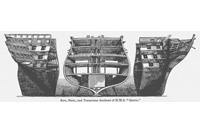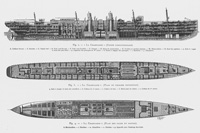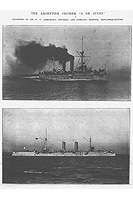Vessel
 This is an image of the cross section of a steamship exhibited at the fourth Paris International Exposition of 1889. The ship featured a steam engine in the middle, and a screw propeller in the stern (left). Even today, screws are almost always used for propelling ships.
This is an image of the cross section of a steamship exhibited at the fourth Paris International Exposition of 1889. The ship featured a steam engine in the middle, and a screw propeller in the stern (left). Even today, screws are almost always used for propelling ships.
In the 18th century, when steam engines were invented, efforts were made to use such engines as a motive power for vessels in replacement of rowing or sailing power. It is said that the world's first practical use of a steamship was conducted in France in 1783, when a boat with paddle wheelson the sides of the body was driven by a steam engine and successfully sailed a river for 15 minutes. In 1807, passenger transportation by paddle steamer began on the Hudson River of the United States, gaining commercial success.
Such steamships, initially used on rivers and lakes, were introduced for sea transportation. As larger and larger vessels started to be built, iron began to replace wood as a construction material in and after the 1820s. As indicated by the commencement of the regular Atlantic steamship service in 1840, sail-powered crafts were replaced by paddle steamers as a means of transportation. Around that time, the development of a screw propeller to accelerate the driving force was promoted, leading to the creation of the Great Britain, an iron ocean liner with a screw as a driving force source (the first modern vessel).
Steam engines were regarded as inappropriate for warships, due to the need for a large installation space. However, alongside the wide use of iron commercial vessels and screw propellers, the introduction of steam engines was discussed. In 1845, the Royal Navy tried a tug-of-war experiment between a paddle ship and a screw ship, resulting in the adoption of a screw ship. The Crimean War, which broke out in 1853, spurred the improvement of the performance of warships. The construction of armored vessels began, such as the Gloire, a wooden warship built by the French Navy in 1859 with protective iron plates, and the Warrior, the world's first all-iron warship built by the Royal Navy in 1860.
During the American Civil War, the first battle between armored vessels was fought. As for the weapons mounted on warships, the installation of not only guns but also torpedoes and other arms was accelerated, leading to the development of cruisers for reconnaissance or the protection of commercial vessels.
The mainstream of steamship engines shifted from a compound engine, which used high-pressure steam and low-pressure steam in two cylinders, to a triple expansive engine, which utilized high-pressure steam, medium-pressure steam and low-pressure steam in three cylinders. Subsequently, a further evolution was realized with the development of a steam turbine engine(whose impellors were rotated by steam) by C. A. Parsons. In 1897, at the event celebrating the 60th anniversary of the accession of Queen Victoria, Parson's Turbinia achieved a speed of 34 knots (about 63 km/h), astonishing the public. (Destroyers in those days reached 27 knots.) The steam turbine soon began to be used for destroyers, and then for commercial vessels. In the 20th century, it was used as a main power source for many renowned vessels, including regular ocean liners and warships.
Vessel (16 images)
 |
 |
 |
| Bow, Stern and Transverse Sections of the Queen Sailing Vessel | Drawings of La Champagne, Steamship | The 9 (Nueve) de Julio, an Argentina Cruiser |
- References:
Cucari, Attilio, Angelucci, Enzo; Hori, Motoyoshi (tr).: Hune no rekishi jiten (Hara shobo, 1985) <NC51-77>
Lavery, Brian; Masuda, Yoshio, Takei, Mari (tr).: Hune no rekishi bunka zukan: Hune to kokai no sekaishi (Yushokan, 2007) <NC51-H95>
Ueno, Kiichiro.: Hune no sekaishi. 1 (Kajisha, 1980) <NC51-50>

